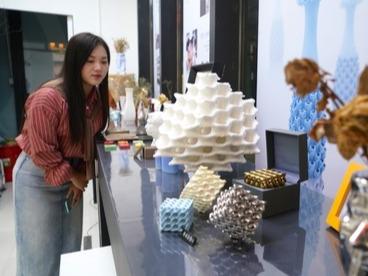Located in Taoxichuan Ceramic Cultural and Creative Block in east China's Jiangxi Province, aesthetically pleasing creative studios reborn from old workshops are now places for ceramic lovers where their dreams come true.
"These were old workshops of the state-owned Jingdezhen Yuzhou Ceramic Factory. From the 1990s, after the industrial reform, its business started to slide until the whole factory was closed," said Liu Zili, deputy director of the Management Committee of the Jingdezhen National Ceramic Culture Inheritance and Innovation Pilot Zone and chairman of Jingdezhen Ceramic Culture Tourism Group.
How to make use of abandoned workshops? "The old ceramic factory is part of the history of the ceramic capital. We want to keep that part of history," said Liu Zili. With Yuzhou Ceramic Factory as the core area, the renovation began in 2013 for a new Taoxichuan Ceramic Cultural and Creative Block. After three years of design and construction, it was officially opened in October 2016.
"The most attractive part of it is its authenticity," Liu Zili told the reporter. During the renovation, 22 old workshops were maintained, and the previous kiln workshops were rebuilt into Taoxichuan Ceramic Industry Heritage Museum and Art Gallery, and the old raw material workshop was turned into a space offering pottery experience now. Every building, every machine, even every brick on the square were old ones left until now.
Old workshops, kilns, chimneys and water towers are still standing there as before, except their internal structures have been renovated to add new functions. With transparent roofs on the top, the old workshops are now creative studios and an art gallery, housing young artists from all over the country and offering space for international art exhibitions and cultural exchange events.
Ceramics are produced in bulk in the industrialized era. Where should traditional ceramic art go from here? How can we make young people fall in love with this ancient art? To revive the ceramic dreams of the youth, Taoxichuan converted the old kiln workshops into the "Yi Space" and provided it to young entrepreneurs and artists for free to sell their ceramic works.
Fanhua Zaowu Ceramic Accessories Studio in Taoxichuan took its first step in the "Yi Space". Ceramic accessories resembling green calabashes, golden osmanthus flowers and colorful auspicious clouds are glittering under the light. "These ceramic accessories with traditional cultural elements are made from clay and fired in kilns," said Zhou Xionghao, the 32-year-old head of the studio.
"I studied ceramics at university. Once at the Taoxichuan Spring and Autumn Fair, I saw someone wearing a necklace made of ceramics. I got inspired and decided to make ceramic accessories that are attractive to young customers," said Zhou Xionghao. These trendy accessories were soon well received by customers. After a few years, the production area of the studio has expanded to over 2,000 square meters from the original merely 6 square meters.
Taoxichuan, with an area of 89,000 square meters, has provided a platform for over 17,000 young makers. "We want to make it a space for young makers and artists where their dreams come true. As long as they love ceramics and art and they have dreams, this will be a home for them," said Liu Zili. (Source: Xinhuanet.com)




 A single purchase
A single purchase









